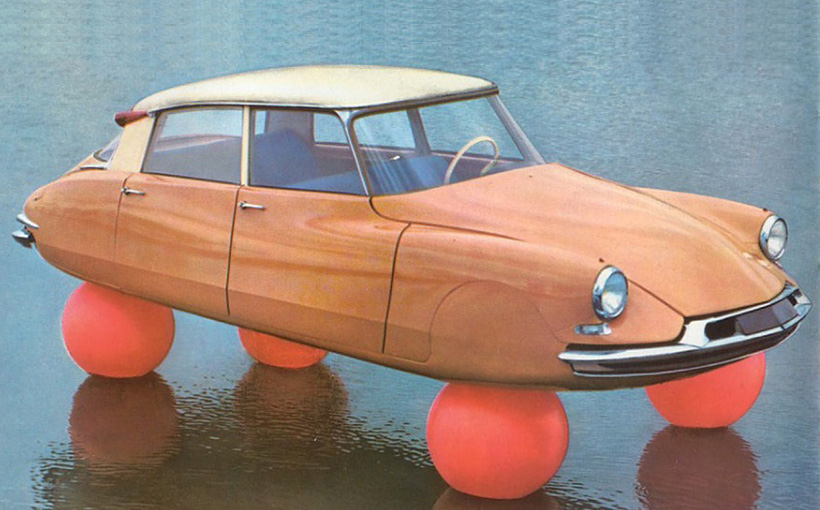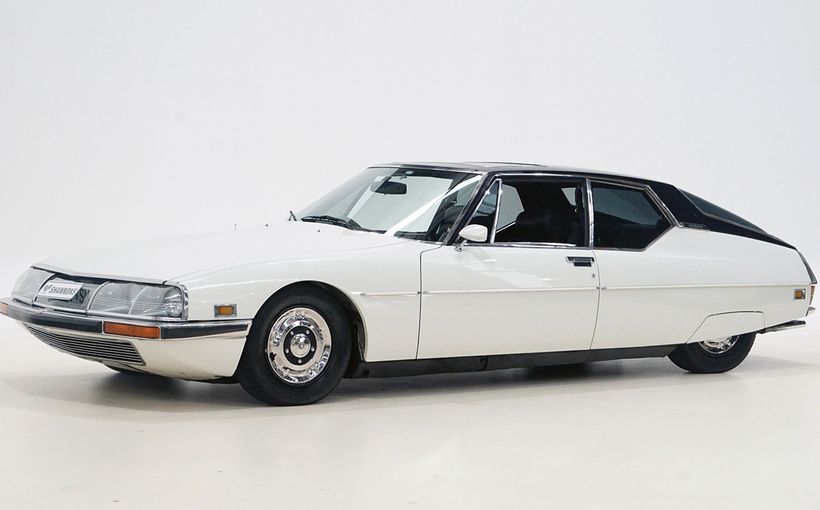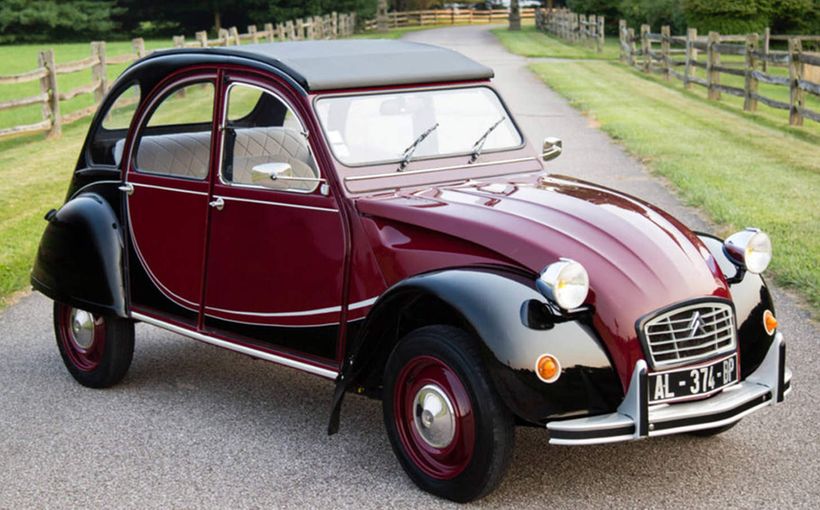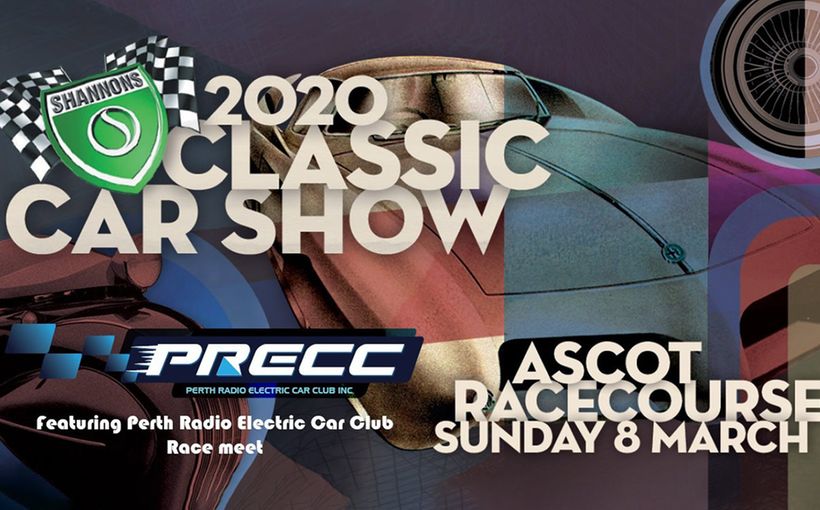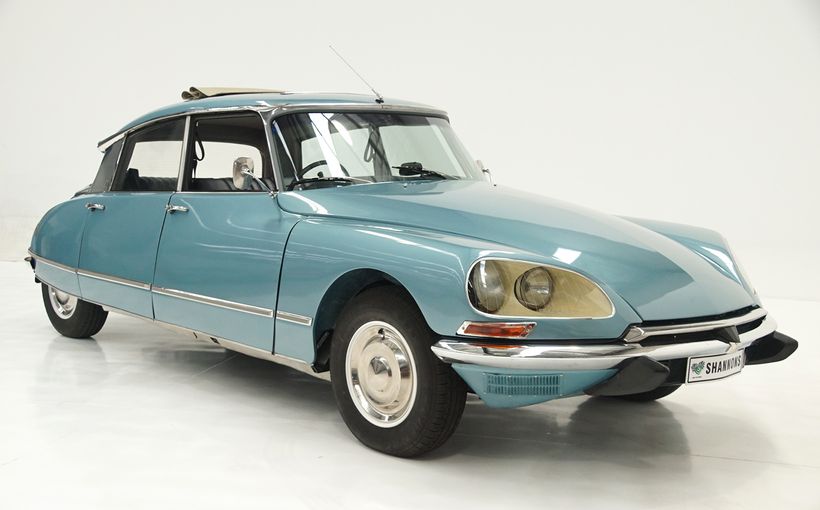1961-67 Citroen ID19: The Aussie Goddess Called Parisienne

For a 1955 release, the Citroen DS, or Goddess as it was more commonly known here from the translation of the French word déesse, stopped the world in its tracks. Not only did its wild new shape point to the future, its revolutionary use of hydraulics, its inboard front disc brakes and use of new lightweight materials were just a sample of the many areas where the new Citroen challenged established thinking. By August 1961, a more basic version of the radical new car was being built in Australia and marketed as the Parisienne featuring a unique combination of local and French parts.

Although the Australian-built Citroen was based on the cheaper ID19, it was better-suited for its application in Australia with simpler and more robust body details and a mechanical specification geared to low octane local fuel and hot, dusty conditions.

Market Traction for Citroen
Following the end of World War II in 1945, the Traction Avant gave Citroen a long buffer to get back on its feet. As Citroen rushed to get the 2CV runabout into production to cater for post-war austerity and the catch-up need for basic transport, the Light 15 family car continued to sell so well in France and export markets that its replacement could wait for a decade.
The Traction was the brain child of two Citroen loyalists, Andre Lefèbvre and Flaminio Bertoni, who would later do the same again for the DS. Although the Traction surfaced in late 1933, the French public had to wait until April 1934 before they could sample the production model. Plans for an additional Super Traction, the forerunner to the new DS, were being formulated as early as 1935.
Because the Traction required such a dramatic convergence of new and largely untried technology, it sent Citroen broke and into the hands of Michelin by 1935. This was not a bad thing as the tyre company used Citroen as a rolling showcase and test bed for its new tyre technology. Under the leadership of Michelin man Pierre-Jules Boulanger, Citroen lost none of its daring and had locked most of the 2CV in place by the time war broke out in 1939. Under the Nazis, Citroen was reduced to making kitchen utensils and had to suspend automotive activities.
The Traction Avant’s new technology would later give the DS a starting point already ahead of rivals. Citroen could push out the envelope even further. The Traction was the world’s first front drive production model with an all steel unitary body. Despite its traditional styling, the Traction’s chassis-less structure generated a much lower centre of gravity and a wide track, ground-hugging stance very different from the usual 1934 models. It also had an unusually long wheelbase with short overhangs.

Its relatively new front drive mechanical layout also dictated hubs on the inner side of the brake drums that could deliver the turning circle buyers wanted before the arrival of the modern CV (constant velocity) joint. Torsion bar suspension at the front and a fully-located beam axle with torsion bars at the rear delivered an astonishing ride. The sharp handling and superior traction could generate unbelievable point to point times that belied the relatively humble four cylinder engine.
Its drivetrain layout was also unusual. The Traction engine was mounted longitudinally like most rear drive cars of the era but turned around back to front so the nose of the engine was up against the firewall. The flywheel end was at the front of the engine bay where it connected up with the transmission and an ancillary pulley that drove the usual ancillary belts. This also left plenty of room for the front wheels to steer without snagging the drivetrain and long equal length drive shafts for exceptional front suspension travel and no torque steer.
Although the Traction didn’t exploit the lost space over the transmission with its tall grille, this layout left plenty of room for a spare wheel and a sharp aerodynamic nose.

There was one more legacy of the Traction apart from its later and improved 1911cc in-line four cylinder engine. One year before the DS launch in 1954, Citroen offered the 15/6 H, the designation for a special six cylinder Traction Avant model with (H)ydraulic rear suspension. Instead of torsion bars, the 15/6 H had a pioneering smaller version of the DS high-pressure hydraulic system, in this case powering the rear suspension only. A belt-driven hydraulic pump pressurised the new system and prepared the market for what was coming.

Because the Traction Avant was assembled in Slough, UK after WWII and could satisfy local British Commonwealth market and currency restrictions, a small but steady flow of these Citroens reached Australia. Apart from their impressive cross-country cruising ability, they were also raced for a much higher local profile than their small sales would have generated otherwise. In the longer term, this ensured acceptance for the more radical DS/ID range.

The Goddess From Another Universe
Just as certain car company cultures can reduce a car to the lowest common denominator, the Citroen culture encouraged the opposite. Yet a dramatic turn of events at a critical point in 1950 when the DS was still being defined could easily have ended the creative Citroen culture. Michelin-appointed Citroen chief Pierre-Jules Boulanger was killed in the Traction Avant he was driving. His replacement would have been quite justified in developing a re-bodied Traction Avant that would have still been more than good enough for the early 1950s.

Citroen engineering protégé Paul Mages under Boulanger’s encouragement had already built his first prototypes by 1949 to develop his pioneering ideas of using pressurised hydraulics to power the steering, brakes and suspension. A Boulanger replacement could easily have dismissed all of this as fanciful. However, visionary Michelin chief Robert Puiseux not only sanctioned this pioneering work but actively protected Citroen from outside interference and the threat of takeover so the DS project could continue as a brand new model.
The Andre Lefèbvre and Flaminio Bertoni Traction Avant team were again let loose. Bertoni defined a new tear drop shape reflecting aero studies of the time. There was a close resemblance to the rear-engined Tatra and Porsche 356 fastbacks except Bertoni was now exploiting the Traction’s low front-mounted transmission to replicate the sleek nose of the Porsche 356.

In fact, the resemblance between the DS nose and the Porsche 356/911 fronts remains strong after Bertoni scrapped the notion of a grille and built cooling slots into the raised centre section of the front bumper and the panel work beneath. For a front-engined water-cooled model, the deletion of a discernible grille or air-intake was radical in the 1950s.
A new flat-six was intended to reduce bonnet height even further except the last minute failure of this new engine to deliver on economy and performance targets forced Citroen to retain a high scuttle line and install a revised version of the wet-sleeve long stroke Traction Avant inline four cylinder 1911cc engine. The new cross-flow aluminium head with hemispherical combustion chambers and twin throat carburettor in DS spec boosted power output to 75bhp/56kW, more than the typical 2.2-litre six of the mid-1950s. This early long-stroke three bearing engine is not to be confused with the short-stroke five bearing engine that appeared much later.

Early DS models had a resonator in the underbonnet section of the exhaust which exited forward of the engine beside the spare wheel then joined the main muffler at the front. Cooling slots in the front undertray kept it cool.
Citroen remained committed to a horizontally-opposed engine for the 2CV and much later GS.
Lefèbvre applied the philosophy of a low centre of gravity, weight reduction and exceptional aerodynamics boosted by extraordinary traction from a front weight bias. He specified a reinforced inner body skeleton that was load-bearing but left the light body panels easily removed with a spanner. The rear guard had to be removed to access the rear wheel.

The huge bonnet would become one of the largest aluminium pressings manufactured at the time while the roof was translucent unpainted fiberglass. Early DS owners talk of the golden glow that fills their cars on a sunny day!
The unitary structure underpinning all this was substantial with an integrated flush floor for smoother airflow and large box sections to maintain rigidity over the long wheelbase. The inner body skeleton was a separate but non-distorting structure that featured unbelievably slender windscreen pillars and rigid surrounds for the frameless door glass to seal against. Citroen installed the side glass so it pressed harder into rubbers as it wound-up, countering the air leaks and wind noise that this design can produce.

Cutting the rear track by 20cm over the front conformed to current aerodynamic thinking but had the added benefit of reducing understeer.
A less visible breakthrough was the self-stabilising centre-point steering geometry. In simple terms, this moved the steering axis through the tyre contact patch. It dictated inboard disc brakes which left room inside the wheels for the large steering hubs with their pivot points directly above the tyre contact patch. The wheels, typical of this geometry as seen on much later front drive VW and Audi models, had their centres almost flush with the outside edge of the rims leaving room for all the steering points inside the wheel.

The steering rack was mounted well behind the front collision zone and the column was a one-piece welded steel item that emerged from the dash with a curved and flattened end that clamped the spokeless steering wheel. The DS is often described as having a single-spoke steering wheel but in fact it was an open ring clamped to a direct extension of the steering column. At the straight-ahead position, the flat steering column section was angled away from the driver. This pioneering Citroen steering package virtually eliminated the horrific injuries of the era when drivers were too often speared by conventional steering columns during a crash.
The centre-point geometry also reduced the turning circle, cut steering reaction on rough roads and allowed it to ignore a change of road surface on one side. It also allowed the DS to maintain its line if a front tyre blew out.

In combination with Mages’ next generation of hydropneumatic suspension on all wheels, this steering system allowed the DS to be driven with a rear wheel removed, a publicity stunt carried out on Sydney streets at the time to highlight the amazing structural rigidity, self-stabilising steering geometry and self-correcting hydro-pneumatic suspension.
The inboard discs had the additional benefit of reducing unsprung weight and isolating the calipers from any suspension forces.
There were many other detailed innovations including face level vents, plastic radiator cooling fan, flush flat section fish tail exhaust with muffler at the front ahead of the front wheels (later changed), flat ribbed floor, reclining seats, B-pillar parking lights, Michelin X steel-belted radials and a later jacking system that involved propping the car at a higher ride height then using the suspension to lift the wheels off the ground.
There was one other innovation that evolved as a sideline to a major last minute change. The DS was finalised ready for production in 1954 with a sweeping six window fastback roofline, similar to an early Vanguard or Hudson.

Bertoni and his team then realised that global styling was quickly moving away from this rounded 1940s two-box look and was starting to embrace the three-box look, with separate boot, cabin and engine room. Panels had also started to flatten out with strong crease lines.
Sketches dated January 1955 showed how last minute changes were made to embrace this trend. A higher, flatter roofline and a wide, flat C-pillar were quickly added over the top of the original side and rear glass and bootlid to create a more clearly defined rear boot section. A strong full-length lower body creaseline added a fashionable flat section, giving the new DS a foot in both camps. Yet the square new roofline looked like it was hovering above the original sloping rear which of course it was.
The solution was to hide the pronounced step down from roof to the rear screen by distracting the eye with two red cones that flowed rearwards at the height of the glass, not the roof above. By using the cones to house the rear indicators, they looked like they were always meant to be there as another innovation.

A second round of sketches dated September 1955 confirmed that this solution was only finalised less than one month before the new model’s first public showing. Because US designs were starting to position turn indicators at the top of tall tail fins, this innovation was perfectly but accidentally timed to create a contemporary look!
The DS hit the ground running. It generated 10,000 orders in the first hour after it went on display at the Paris Salon in October 1955. By the end of the show this had grown to 80,000. Little did these early adopters know they would become part of a critical post-factory development program!

The DS Hydraulics
When project leader Andre Lefèbvre had trouble explaining how the new hydraulics worked at the DS launch, it would take more space than available here.
Yet there are some features that require listing to make sense of how the Australian cars were specified.
The original DS system had a high-pressure hydraulic pump driven by a rubber belt hooked up to the fan belt pulley. This supplied hydraulic line pressure to the four corners of the car where it pressurised spheres filled with gas hence the hydro-pneumatic description of the suspension.
Unlike the BMC Hydrolastic fluid suspension system which was sealed with fluid without an external pressure source, the Citroen’s hydraulic system could vary the pressure in each sphere and compensate for a wide range of different conditions including load, cornering forces, specified ride height and the severity of road surface. When stopped, the Citroen would slump onto its bump stops. When running, the suspension would pump back up but then slump as each passenger climbed on board then automatically return to normal ride height. The reverse would occur as they left the car.

The clever part was exploiting this constant line pressure for other purposes, when it was already there. By introducing this line pressure to the brake’s hydraulic lines, the need for a brake pedal and separate master cylinder was eliminated. All the driver needed was a foot-operated tap that allowed the hydraulic pressure to enter the brake system at the required amount for the braking required. It’s why Citroen DS and later ID models with the full hydraulic system have a small button on an elevated floor section between the clutch and accelerator pedals instead of a brake pedal.
The other breakthrough was to use this same line pressure to replace the traditional separate belt-driven power steering pump. Like the DS brake button, the steering system had a similar pressure tap system that regulated the line pressure allocated to the steering to reduce steering effort at any given time.
Hydraulics were also exploited to deliver a semi-automatic gearbox based on Citroen’s manual transmission. A hydraulic system installed in the top of the gearbox replaced the manual linkages. The driver controlled it by a fingertip lever which also doubled as a control for the starter motor so it couldn’t be started in gear. The lever also actuated the clutch. Although this system appeared on imported Citroens, it was never fitted on locally-produced models.
The system was brilliant except a simple belt failure would cut the brakes, steering and suspension in one hit with the semi-automatic transmission in certain models adding to the complications this could create. Citroen’s built-in fail-safe measures brought the car to an immediate stop if this happened but that wasn’t the point. With the car disabled to this extent, there was no limp home mode and it took more than fitting a new belt to get going again.
The other problem was that 1950s fluid technology had not kept up. Early Citroen DS/ID models had “red fluid” hydraulics that relied on fluid that was very hygroscopic, sucking moisture into the system for extensive damage and rust if it wasn’t flushed out on a routine basis. The later green fluid update was far less labour intensive and a much easier ownership proposition, especially today when the red fluid is no longer available.

Key DS/ID Updates Before Australian Assembly
Before local assembly started in August 1961, Citroen DS and ID RHD imports came from France, South Africa and Slough, UK. Although they varied considerably in detail including a wood panelled dash on the British cars, some changes were consistent.
In early 1956, the DS gained a five-setting control to raise and lower the suspension for clearing obstacles and lifting the wheels for tyre changing. Later on in 1956, the hydraulic pump was driven by two belts. At the close of 1959 ready for the 1960 models, the rear guards were lengthened with a more pronounced recess for the rear bumper and a tighter fit around the raised centre bumper section. The slender side-mounted reflector holders were dropped and the reflectors simply tacked onto the trailing edge of the rear guards.

The electrics were switched from 6 volt to 12 volt for 1961 models. The DS engine was given domed pistons for a boost in compression ratio boosting power from 75bhp/56kW to 83bhp/62kW.
The ID19 announced in October 1956, started out as a stripper - no hubcaps, fixed seats, painted headlight surrounds, no headlining, rubber matting all round, simpler seats, plastic door hardware, plain black or brown plastic for the rear indicator cones and a bigger steering wheel to compensate for the lack of assistance. Brakes had their own conventional master cylinder and were also unassisted. A single choke carburettor pegged power back to 66bhp/49kW. The idea behind the ID19 was to offer the basics with as few complications as possible.

The ID19 was the obvious choice for local conditions but not before it received several running changes. In October 1958, the ID19 gained chrome headlight rims, hubcaps, parking lights in the B-pillars and rectangular rear reflectors. In late 1959, the B- and C-pillars gained ribbed aluminium trim. Later in 1960, the switchgear was changed, the bootlid was given a telescopic stay, the boot was lined and gained a courtesy light.
It was in this late 1960 specification with several local improvements that the ID19 went into local production.

The Australian ID19
The big shift which led to local Citroen production for the first time was the easing of British Commonwealth sourcing restrictions in 1960 along with further incentives to place new models into local assembly direct from the original factory. These changes meant that the ludicrous triple handling of Citroens from partial assembly on the original French assembly lines to final assembly on British assembly lines before shipping them to Australia was ended.
It led to an immediate price drop from around 2,000AusPound /$4000 to 1700AusPound/$3400.
Local importer and assembler Continental and General which also handled Peugeot, Renault, Studebaker and NSU added Citroen to its Heidelberg West assembly lines near Melbourne, Victoria after a new agreement was reached in mid-1961. It joined a revised range of Peugeot 403 and 404 models.

The new Citroen ID19 went into local production several months later and hit local showrooms before the end of 1961. Although pricing differed in NSW and Victoria, the price was reduced by a further 100AusPound/$200 for an average of around $3200, a huge drop compared to what buyers were paying in the late 1950s. A number of DS19 imports also reached Australia during this period from several sources.
A number of French-built RHD imports built to South African hot climate/dusty road requirements filled the gaps until then. These imports had a RHD metal version of the current French dash which in its earlier LHD plastic guise would not have survived local heat and rough road conditions.

The Continental and General ID plates were similar to other models it assembled in Australia. The body number repeated the engine number allocated to the engine when it was built in Paris. The Series Number was a local identification number applied by C and G. Early local cars had a 6 prefix, later cars (around early 1964) had to skip to a 12 when 6999 was reached.
NSW sales were handled by Buckle Motors, a family operation long associated with Citroen and well-known through Bill Buckle’s activities with Goggomobil and his Zephyr-powered sports car. These cars had a Buckle Motors plate placed over the top half of the C and G plate leaving the original numbers visible.
Because there were significant differences between the earlier Slough-built examples, a Melbourne dealer highlighted the new direct link with the French factory in 1960 by calling the first of the new French imports, Parisienne. It was a name that stuck and would apply to all locally assembled examples as their key parts came directly from France.

The key distinguishing points of C and G assembled ID19 examples included:
CABIN: High-quality local vinyl trim (some earlier cars had two-tone, all later cars single tone) that replicated the pleated stitch pattern of the French upper level ID19 models, thinner, firmer seats than the plump French versions, rubber matting in the front, carpet minus the foam backing in the rear, RHD French-style steel dash with white steering wheel, fan style speedometer and sloping painted glovebox and centre section.
MECHANICALS: Pendant brake pedal and conventional master cylinder, single cylinder hydraulic pump, locally-made oil bath oil cleaner different from the French export spec version, early cars had column shift manual with separate gearshift planes for non-synchro 1st and tall 4th but most if not all local production had the later gearbox with the conventional H-pattern shift, all local cars had red fluid hydraulics. The first local examples had dash-mounted manual spark advance-retard but this was swapped during 1962 to a more conventional vacuum advance-retard mechanism. All local cars had 400mm wheels often later changed to 15 inch rims by owners for a wider tyre choice. Several reports suggest local cross-plies were fitted to early local cars while press cars were supplied with Michelin X.

EXTERIOR: Stainless steel exterior trim including the rear indicator cones, single centre-bolt wheel fastening with small aluminium centre hub caps, aluminium roof with flock lining on early cars, vinyl lining on later examples, French-style front bumper with inclined number plate mount.
ELECTRICALS: Large French round headlights (SEV Marchal or Cibie) versus the smaller British ones of earlier Slough cars. French starter motors, generators and ignition (SEV Marchal, Paris Rhone or Ducellier)
LOCAL COLOURS: 0070 Black, 4318 Angora White, 4319 Lido Blue, 4320 Curaçao
4322 Reims Grey, 4323 Boulogne Green, 4981 Mistral Grey, 4988 Alouette Ivory, 5376 Carmen Rouge, 5394 Olive Green, 9936 Charcoal Grey
LOCAL TRIM COLOURS: Two-tones included red/black, red/white, blue/white, salmon pink/white, pale blue/white. Single tone after 1963 ½ upgrade included red, blue, salmon, pale blue, light tan, black.

The 1963 ½ Update
The local ID19 gained the major rework of the front body section with V-shaped overriders and a sharper, more streamlined nose. A new inclined front panel with vents was added between the overriders and replaced the earlier centre slot.
A short undertray below the bumper replaced the front-mounted muffler which was moved to a transverse recess in the centre floorpan.
The engine was boosted in compression ratio from 7.5:1 to 8.5:1 but retained the single throat Solex 34 PBIC for a boost in power to 75bhp/56kW from the 69bhp/51kW of the first Australian cars. The twin throat Weber 24/32 could be specified on special order lifting power to later DS19 levels.
The original dash and white steering wheel continued. It was widely reported at the time that the gearshift pattern changed to a conventional H-pattern shift with this upgrade.

This in fact occurred during 1962 as a running change. The big mechanical change was the scrapping of the separate brake master cylinder and reverting to the pressurised brake system of the DS. The pendant brake pedal was dropped and replaced by a button on an angled steel foot platform.
The single bolt wheels continued but Michelin X steel-belted radials were now fitted as standard. Contemporary road tests suggested the price was increased by 100Aus Pound/$200 to cover the cost of these imported tyres, well worth it as most Citroen owners were changing them anyway.
After this upgrade arrived, Australian tariff and local content rules changed again requiring manufacturers to commit to increased local manufacture or revert to full import status from 1964. Continental and General effectively became redundant after building its business around meeting minimum local content requirements, not full local manufacture.

From this point, local Citroen ID19s were built from a combination of parts left over from the 1963 ½ upgrade supplemented by various French upgrades as certain bits ran out. The last examples were cleared in 1967 by which time Renault had taken over the Heidelberg West facility for Renault and Peugeot assembly.
This would explain why only the last 40 or so examples featured some but not all the new features that appeared in French models after 1964. This included a new dash design with a black steering wheel, rectangular speedo, upright black centre dash and glovebox section. Also introduced randomly but not always with the new dash was the upgraded engine with the new crankshaft damper at the nose of the engine, which in this case was at the rear of the engine as installed in the car. A variation of the early long stroke engine and not the new five bearing unit, this upgrade added another 5bhp/4kW.

The later twin-throat Solex carburettor upgrade and the five stud wheels which were the correct specification for a French 1966 model were never applied to local cars, just like similar upgrades were denied to local Studebaker models during this period when C and G dealers were still clearing the last of their stock.
This suggests the last cars were probably built at the end of 1965 or early 1966. The most accurate estimates suggest that barely 1200-1300 cars were built during that 1961-66 period. Unlike Studebaker which ultimately shut down altogether globally, Citroen enjoyed a second life as an import after several major facelifts injected new life into the DS models and other models such as the GS came on stream.

Footnote: The writer would like to acknowledge the assistance of the Citroen Car Club of Victoria Inc. The information that aussiefrogs.com members are uncovering in their Longstroke ds/id census must also be acknowledged. Their census has dictated adjustments to earlier information which have been made as required. The book “Citroen DS-The World’s Most Beautiful Car” by Daniel Denis and Thibaut Amant was translated into English in 2012 and also proved a useful reference.

Protect your Citroen. Call Shannons Insurance on 13 46 46 to get a quote today.

